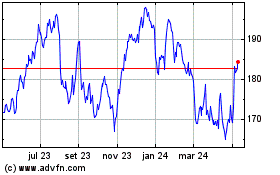By Tripp Mickle
After losing his job last week as a sports-radio producer, Adam
Michaels scrutinized his family's spending. Among this year's
planned cutbacks amid the economic devastation wrought by the
coronavirus pandemic: no new iPhones.
It is a departure for the 42-year-old, Chicago-area resident,
who typically buys his family four new iPhones every two years.
"The expense is not worth it right now," Mr. Michaels said.
The question of consumer demand looms large for Apple Inc. as it
prepares to unveil a new low-price iPhone model and soon must begin
ordering components for its latest flagship smartphones, which
usually are launched in the fall. The fall iPhones, which this year
were expected to garner significant consumer interest because of
the use of 5G wireless technology, make up a sizable portion of the
company's revenue.
An Apple spokesman declined to comment.
Consumer demand in the age of coronavirus has quickly emerged as
the biggest unknown for companies from soft-drink makers to
airlines. European and U.S. lockdowns have triggered a sharp,
unprecedented economic contraction that has left many businesses
without a road map for what lies ahead.
Apple, which has navigated past economic challenges, has been
whipsawed by the viral outbreak. The health crisis began in China,
where it closed factories and eroded iPhone supplies. It then
bounced to Europe and the U.S., forcing Apple to shut down stores
and almost all activity at its Silicon Valley campus.
Sales of iPhones peaked in 2015, and the company has been
focused on persuading customers to replace old devices -- a much
tougher task amid an economic crisis. The less-expensive iPhone
heading to the market could be a better fit for a cost-conscious
time, but its lower price and targeted audience -- emerging markets
and existing customers -- also will make it a modest contributor to
Apple's bottom line. The new model, which has been compared with
the $399 iPhone SE offered in 2016, was expected to be launched
this month but might be delayed, analysts say.
Apple's new flagship models are usually unveiled in September,
so the 5G phones are months away. However, the company's operations
team typically places orders in March and April for camera modules
and other components for iPhone assembly in summer months, former
employees said.
They said orders dictate how many new devices Apple makes, and,
under the shadow of the pandemic, consumer demand has never been
more unclear. It is further complicated by lofty iPhone prices,
after Apple three years ago raised its flagship models to $1,000 --
a 50% increase that lifted revenue as shipments fell.
The uncertain market has unnerved Apple's suppliers, who said
they are now concerned iPhone shipments will decline this year
instead of rising, as many analysts had expected. Apple's next
quarterly report is due out in late April. In 2018, suppliers
suffered when Apple misread demand and slashed production, sticking
some suppliers with excess inventory and underused production
capacity.
The coronavirus has already hammered the smartphone industry,
which compared with a year earlier shipped 38% fewer units
world-wide last month amid China's shutdown, according to Strategy
Analytics. It was the biggest single-month decline in industry
history.
Apple relies on Europe and the U.S. for about two-thirds of
sales and faces growing risk as those countries now combat the
public-health crisis. The U.S. alone is predicted to lose as many
as five million jobs this year as restaurants, airlines and hotels
reel in the face of travel restrictions.
Apple's shares have fallen about 15% in the past month, in line
with tech peers such as Microsoft Corp. and Facebook Inc. but less
than the 28% decline in the S&P 500, according to FactSet.
Apple Chief Executive Tim Cook has encouraged staff in emails
not to worry about the challenges confronting the company. He
indicated that Apple -- which has about $200 billion in cash and
cash equivalents -- is prepared for this moment and will continue
to invest in the future.
The company has forged ahead with software updates and new
products, including an updated MacBook Air and iPad Pro. Apple also
has pushed to increase sales of apps with an App Store expansion
into 20 new countries.
Pressure to order the right number of components in the face of
fast-changing consumer behavior is especially high as Apple moves
into 5G, the next generation of wireless technology. The 5G models
require pricier modems and more memory that analysts say will
increase costs of materials by $100 a phone.
Being stuck with extra modems or unsold 5G iPhones could cut
into the rich profit margins that helped make Apple the first U.S.
company valued at $1 trillion, said Mehdi Hosseini, an analyst with
Susquehanna International Group. He expects Apple to have component
suppliers continue making iPhone parts as planned while it
reassesses demand in May or June.
The factories Apple relies on in China to make its products have
restarted operations, but a stay-in-shelter order in California has
forced staff to work remotely, complicating the well-oiled process
that has long guided Apple's iPhone development.
Apple is scrambling to prevent product delays. Unable to travel
to China, its U.S. engineering team is using video calls to direct
Chinese colleagues through iPhone prototype assembly at factories
in Asia, people familiar with the matter said. The company
previously did a test run of that process in January.
The company last week also began allowing some engineers to take
home prototypes of some future products, people familiar with the
matter said, an unprecedented step for a company that has fired
software engineers for coding off campus and used security staff to
transport future iPhones. It asked employees not to discuss the new
protocols.
Write to Tripp Mickle at Tripp.Mickle@wsj.com
(END) Dow Jones Newswires
March 26, 2020 05:44 ET (09:44 GMT)
Copyright (c) 2020 Dow Jones & Company, Inc.
Apple (NASDAQ:AAPL)
Gráfico Histórico do Ativo
De Mar 2024 até Abr 2024

Apple (NASDAQ:AAPL)
Gráfico Histórico do Ativo
De Abr 2023 até Abr 2024
